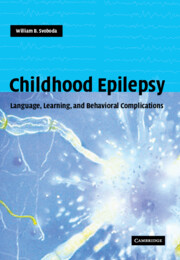Book contents
- Frontmatter
- Contents
- Preface
- Glossary
- 1 Looking ahead
- Part I Speech and language problems
- Part II Learning problems
- 12 Learning challenges
- 13 The development of learning
- 14 Learning difficulties
- 15 Learning problems with seizure types
- 16 Modifying factors
- 17 Transient cognitive impairments of epilepsy
- 18 Attention and alertness
- 19 Memory
- 20 Executive functioning
- 21 Academics
- 22 Antiepileptic medication effects
- 23 Effects of other therapies
- 24 Diagnosis
- 25 Gaining help
- 26 Frustrations of learning problems
- Part III Behavior problems
- Index
- References
14 - Learning difficulties
from Part II - Learning problems
Published online by Cambridge University Press: 26 October 2009
- Frontmatter
- Contents
- Preface
- Glossary
- 1 Looking ahead
- Part I Speech and language problems
- Part II Learning problems
- 12 Learning challenges
- 13 The development of learning
- 14 Learning difficulties
- 15 Learning problems with seizure types
- 16 Modifying factors
- 17 Transient cognitive impairments of epilepsy
- 18 Attention and alertness
- 19 Memory
- 20 Executive functioning
- 21 Academics
- 22 Antiepileptic medication effects
- 23 Effects of other therapies
- 24 Diagnosis
- 25 Gaining help
- 26 Frustrations of learning problems
- Part III Behavior problems
- Index
- References
Summary
Up to 50% of children with epilepsy have learning difficulties (Rutter et al., 1970; Holdsworth & Whitmore, 1974; Whitehouse, 1976; Stores, 1978; Stores, 1987; Thompson, 1987), with up to 30% at risk of developing serious learning problems (Aldenkamp, 1991). The main problems are mental retardation, intellectual decline, learning disabilities, and underachievement. The seizure type and etiology, age of onset, frequency, severity, duration, and effects of seizure therapy modify the academic presentations. Some problems are potentially reversible, but others are permanent (Cornaggia & Gobbi, 2001).
Around 50% of children with epilepsy have some school difficulties, but less than 1% attend special epilepsy schools (Cornaggia & Gobbi, 2001). Around 30% of children with therapy-resistant epilepsies receive special education help (Green & Hartlage, 1971; Holdsworth & Whitmore, 1974; Aldenkamp, 1983; Thompson, 1987; Ross & Tookey, 1988). Children with epilepsy tend to drop out of school earlier. By adolescence, only 33% of epileptic children are in the secondary school system (Rodin et al., 1972; Thorbecke, 1987). The dropout tendency relates somewhat to the sociological status and attitudes of the family (Suurmeijer et al., 1978; Long & Moore, 1979; Aldenkamp et al., 1990). This leads to occupational disadvantages and a higher unemployment rate (Rodin et al., 1972; Thorbecke, 1987).
Learning problem confusion
A specific cognitive functional impairment is a reduction in the capacity of the child to learn. This is a learning disability, which is different to mental retardation and intellectual deterioration.
Information
- Type
- Chapter
- Information
- Childhood EpilepsyLanguage, Learning and Behavioural Complications, pp. 186 - 202Publisher: Cambridge University PressPrint publication year: 2004
